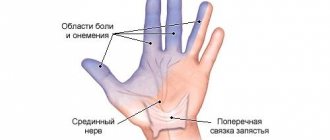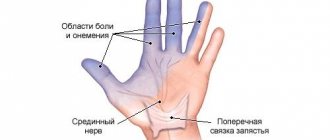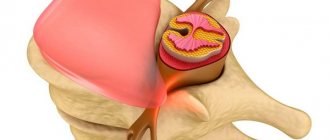Diseases of the optic nerve differ significantly from pathologies of the eye itself (iritis, glaucoma, cataracts, etc.). In these conditions, the formation and transmission of impulses to the brain is disrupted. Their symptoms can occur in people who have never had problems with color vision or visual acuity. A distinctive feature is also the rapid development and completion of the acute period. Most often, the visual pathway is affected by an inflammatory process – neuritis.
To understand the symptoms and principles of diagnosis, it is necessary to know the basic anatomy of the eyeball and optic nerve.
Structure of the eye and optic nerve
In order for a person to see something, the light that is reflected from all objects in the surrounding world must reach the receptors of the optic nerve (cones and rods). However, before this, it passes through several structures of the eye. Let's list them, starting with the most superficial:
- The conjunctiva is a thin membrane that covers the eyelids and the outer surface of the eye. It is not of great importance in the transmission of light, however, infectious processes (conjunctivitis) can transfer from it to the nerve;
- The cornea is a slightly convex transparent plate that is located in the front of the eye. Lies most superficially (immediately under the conjunctiva);
- Pupil and iris - under the cornea there is a cavity filled with liquid, and behind it is the iris. This part is shaped like a ring. The hole inside is called the pupil. The iris can narrow or expand, depending on this, the amount of passing light changes;
- The lens is the “lens” of the eye, which can change its shape with the help of the ciliary muscle (body). Thanks to the lens, a healthy person can see distant and nearby objects equally clearly;
- The vitreous body is a jelly-like mass. The last structure that refracts light in the eye;
- The retina is represented by rods (responsible for twilight vision) and cones (perceive color). This is the initial section of the optic nerve. They form an impulse and send it further along the visual path.
All these structures are mainly nourished by the choroid, which is located directly behind the retina. Diseases of the parts of the eye that conduct light develop slowly and lead to vision loss only in the later stages. Neuritis occurs much faster and primarily impairs visual function.
In order to promptly suspect inflammation of the optic nerve, you should know the most common causes that can lead to this condition.
Methods for diagnosing optic nerve neuritis
Due to the strong similarity of symptoms of different types of disease, conducting competent, timely diagnosis is very important. Modern ophthalmology has the following methods:
- Clinical assessment of the patient’s eye condition - it involves an initial examination and collection of data about the patient’s life and illness. In this way, the possibility of the occurrence of infectious or another type of neuritis is established.
- Ophthalmoscopy is a way of examining the fundus of the eye using special instruments. It allows you to differentiate pathology and assess the condition of the retina, optic nerve head or blood vessels.
- MRI - using magnetic resonance imaging, tomographic images of the optic nerve are obtained, allowing one to draw a conclusion about its changes (thickening or dystrophy) and suspect the initial stage of multiple sclerosis.
It must be remembered that an effective diagnosis of inflammation of the optic nerve can only be carried out by an experienced specialist with a timely visit to the clinic.
Causes
Optic neuritis can occur only in the presence of another infectious pathology. Therefore, when diagnosing, it is important to look for the presence of the following concomitant (or recent past) diseases in the patient:
- Any inflammatory processes in the eye:
| Affected part of the eye | Name of the disease |
| Iris | Iritis |
| Iris and ciliary body | Iridocyclitis |
| Choroid | Choroiditis |
| Cornea | Keratitis |
| Outer shell of the eye | Conjunctivitis |
- Injuries to the bones of the orbit or their infection (osteomyelitis and periostitis);
- Inflammation of the air sinuses (frontitis, sphenoiditis, sinusitis, etc.);
- Tonsillitis;
- Various chronic infections caused by specific microbes: neurosyphilis, diphtheria, gonorrhea, typhus and others;
- Infections of the membranes and tissues of the brain (encephalitis, encephalomyelitis, any meningitis and arachnoiditis);
- Inflammatory processes in the oral cavity (caries, periodontitis, etc.), which can also spread along the facial tissue to the optic nerve.
The development of the disease a few days (4-7) after influenza or acute respiratory viral infection is very typical. Therefore, if any symptoms of optic neuritis appear, you should consult a doctor.
Symptoms
The first signs of the disease develop unexpectedly and can manifest themselves in different ways - from decreased/loss of vision to pain in the orbital area. Depending on the affected part of the visual pathway and the clinical picture, two forms of neuritis are distinguished:
- Retrobulbar - the optic tract is affected after exiting the eyeball.
- Intrabulbar - the inflammatory process has developed in the initial segment of the nerve, which is located within the eye;
It should be noted that symptoms of optic neuritis often occur on only one side.
Symptoms of intrabulbar neuritis
The disease always begins acutely - the first signs appear within 1-2 days and can progress quickly. The more damage to the optic nerve, the stronger the symptoms. As a rule, with the intrabulbar form, the following changes in visual function can be detected:
- The presence of scotomas is the most characteristic sign of neuritis, in which the patient develops blind spots in the field of vision (mainly in the center). For example, a patient can see with one eye all objects in the environment, with the exception of those that are directly in front of him;
- Decreased acuity (myopia) is observed in every second patient. More often, myopia is slightly expressed - vision decreases by 0.5-2 diopters. However, if the entire thickness of the nerve is damaged, the eye completely loses vision. Blindness may be reversible or irreversible, depending on the timing of treatment and the aggressiveness of the infection;
- Impaired “twilight” vision - the eyes of a healthy person begin to distinguish objects in the dark after 40-60 seconds. In the presence of neuritis, on the affected side, vision adaptation takes at least 3 minutes;
- Changes in color vision - the patient may lose the ability to see some colors. Also, when the nerve is irritated, blurry colored spots may appear in the field of vision.
Intrabulbar neuritis, on average, lasts from 3 to 6 weeks. Its outcome can be different - from complete restoration of eye function to one-sided blindness. The likelihood of an unfavorable outcome can be reduced with adequate and timely therapy.
Symptoms of the retrobulbar form
This neuritis is somewhat less common than the intrabulbar form. Since the nerve lies freely in the cranial cavity (not counting the surrounding tissue), the infection can spread in two directions: along the outer surface (peripherally) and along the inner surface (axially). The most unfavorable case is when the entire diameter of the optic nerve is affected.
Depending on the location of the infection, the symptoms of the disease will differ:
| Type of retrobulbar neuritis | Where is the infection located? | Characteristic symptoms |
| Axial | At the center of the optic nerve |
|
| Peripheral | On the outer nerve fibers |
|
| Transversal (transverse) | The inflammatory process develops throughout the entire thickness of the nerve trunk | Combines signs of axial and peripheral types. |
Due to the characteristic symptoms, a diagnosis of optic neuritis can be assumed. However, to confirm it, additional diagnostics are necessary, which will clarify the presence of infection and its location.
Helpful information
To understand the essence of the problem of people diagnosed with optic neuritis, it is worth taking a closer look at the optic nerve. It is known that anatomically it has a process structure. It represents the neurons of the retina. The latter can absorb visualization and transmit information about it in the form of nervous vibrations. Their transportation is transmitted along axons to the visual part of the cerebral zone. All parts of a nerve are made up of millions of branches. The origin comes from the disk, which is located on the retina. It can be seen during a routine examination by a doctor. That part located in the inner region of the orbit is called intrabulbar. When the optic nerve leaves the orbit and makes its way to the cavity of the cranium, this part of it is called retrobulbar. The ending takes place in the visual centers of the midbrain and diencephalon. Along its entire length there are dense membranes, closely connected with nearby parts of the orbit, brain and cerebral surfaces. Therefore, quite often neuritis manifests itself in the formation of inflammatory anomalies.
Diagnostics
Laboratory diagnostic methods are not of fundamental importance for eye diseases. In a clinical blood test (CBC), the number of WBC/leukocytes may be increased - more than 9*109/liter. It is also possible to accelerate ESR by more than 15 mm/sec. However, these changes only indicate the presence of inflammation and do not indicate its location and cause. Urine, feces and venous blood tests usually remain normal.
The most informative are special ophthalmological methods that make it possible to diagnose intrabulbar neuritis in the early stages. These include:
- Ophthalmoscopy is a method that does not require special equipment. The examination is performed in a dark room, where the doctor examines the patient's fundus through the pupil using a magnifying lens. Thanks to the method, it is possible to study the initial part of the optic nerve - the optic tract. With neuritis, it will be swollen, hyperemic (reddened), and pinpoint hemorrhages are possible;
- Fluorescein angiography - this method allows you to clarify whether the optic disc is completely or partially affected. During the examination, the patient is injected with a special substance into a vein, which will “illuminate” the vessels in the fundus of the eye, after which the doctor evaluates them using a special device (fundus camera). Angiography is used only in large/private clinics, since the method is quite expensive. The average price is about 3,000 rubles.
The above methods are not informative for retrobulbar neuritis, since it is not the optic disc that is affected, but the section of the nerve after it exits the eye. Changes in the disc are observed only by the 5th week. The diagnosis is made based on complaints and excluding other eye diseases.
How to distinguish toxic neuropathy from neuritis
These two diseases are very similar in symptoms, but differ in treatment tactics and prognosis. To prescribe effective therapy, the correct diagnosis should be made as early as possible. To do this, you need to analyze the following nuances:
- The cause of the disease is that viruses or microbes always play a major role in the development of neuritis. Toxic neuropathy most often appears due to exposure to methyl alcohol or large amounts of 40-proof alcohol (more than 1.5 liters). Possible causes also include: Poisoning with heavy metals or their salts (lead, antimony, mercury);
- Overdose/individual intolerance to certain drugs: NSAIDs (Aspirin, Ibuprofen, Ketorolac, etc.), synthetic antibiotics (Sulfadimethoxine, Sulfacetemide) and cardiac glycosides (Digoxin, Strophanthin);
- Poisoning by vapors of phenol-formaldehyde resins (contained in regular cigarettes and smoking mixtures).
Using the above signs, toxic neuropathy can be identified. The main principle of its treatment is the elimination of the damaging factor (alcohol, metal, medicine) and its removal from the body. After this, the work of the nerve and its blood circulation are stimulated with the help of drugs such as Neuromidin, Trental, Actovegin, etc.
In most cases, vision changes become irreversible and the effect of treatment is to improve the general condition.
How does optic neuritis manifest?
The main problem of patients with this diagnosis is acute visual impairment. The degree of severity and type of process is directly dependent on the level of damage to a particular area of the organ. In cases of severe disease, visual acuity may drop to critical levels, causing blindness. When areas are partially captured, the vision level can be maintained at 1.0. But at the same time, the patient develops blind areas, has low color perception, difficulties in adaptation in the dark, functional mobility of the nerve and a dangerous frequency of comparison of flickers.
In the early period, patients are diagnosed with disc deformation, that is, swelling, blurring of the border, dilation of blood vessels, the appearance of blood leaks, etc. The most dangerous acute period of the disease lasts around 3-5 weeks. Then the symptoms gradually begin to fade, the hemorrhages resolve, and the disc line becomes clearer again.
Treatment
First of all, the cause of the disease – an infection of the optic nerve – should be eliminated. Therapy depends on the microorganism that caused the disease. If it is a virus, it is necessary to prescribe antiviral drugs (Amiksin is recommended); if there is a microbe, an antibiotic is used. Unfortunately, in most cases it is impossible to detect the cause of neuritis. Therefore, all patients are prescribed an antibacterial drug that acts on a large number of different microorganisms. As a rule, this is a combined penicillin (Amoxiclav) or a cephalosporin (Ceftriaxone).
In addition, the standard treatment regimen for optic neuritis includes:
| Drug group | Why is it prescribed? | How is it used? | The most common representatives |
| Glucocorticosteroids | Used to reduce inflammatory reactions: swelling of the nerve/optic disc and damaging processes. | If the patient has retrobulbar neuritis, local injection of hormones is possible - using a special syringe into the tissue behind the eye. In the intrabulbar form, general glucocorticosteroids are predominantly used. | Dexamethasone; Hydrocortisone; Methylprednisol. |
| Detoxification drugs | Used as intravenous infusions (droppers) | Hemodez; Reopoliglyukin. | |
| Vitamins | Improves metabolism in nervous tissue. Slightly stimulate the transmission of nerve impulses. | In the hospital they are usually used in the form of intramuscular injections. At the outpatient stage, tablet forms can be used. | PP (nicotinic acid); B1(thiamine); B6 (pyridoxine); Neurobion is a combination drug. |
| Medicines that improve microcirculation | Improves nutrition of nervous tissue | They are used mainly after an acute period of illness with a pronounced decrease in visual functions. | Trental; Nicergoline; Actovegin. |
Also, therapy can be supplemented with drugs that improve impulse transmission along the nerves. These include: Neuromidin, Nivalin, etc. It should be noted that only a neurologist can decide on the need for such treatment.
In addition to drug treatment, physiotherapy may be prescribed. The need for it may arise if there is severe visual impairment after an illness. The most common methods are magnetic and electrotherapy, laser eye stimulation.
Structure and functions
In order to imagine the process of neuritis of the optic nerve, it is necessary to consider its structure and functions. It consists of neuron axons (processes) that extend from the retina. The nerve, consisting of more than 1 million fibers, transmits signals in the form of impulses to the visual center of the brain. It originates behind the disc of the organ of vision.
The area inside the retina where the optic nerves are located is called intrabulbar, or intraorbital. The area where the fibers enter the cranium is known as the retrobulbar.
In neurology, the optic nerve performs several functions:
- ensures the ability of the eye to distinguish objects of different sizes (visual acuity);
- provides the ability to distinguish colors;
- determines the visibility area (the boundaries of the field of view).
If this inflammatory disease develops, the functional abilities of the eye simultaneously decrease.
Neuritis of the eye cannot be completely cured. This is due to the fact that decreased visual function causes degeneration of nerve fibers that cannot be restored.
Prevention
Since nerve damage occurs only in the presence of other diseases, the only measure to prevent neuritis is timely treatment of infections. Particular attention should be paid to eye diseases, which often spread through surrounding tissues to the nerve trunk or optic disc.
Optic neuritis can lead to irreversible loss of eye function or one-sided blindness. These conditions can be prevented with a high probability by promptly contacting a doctor if you suspect characteristic symptoms. At a medical institution, an additional examination will be carried out, which will allow a final diagnosis to be made. After this, complex treatment from several groups of drugs is prescribed for 4-6 weeks and, if necessary, physiotherapeutic procedures.
Author:
Selezneva Valentina Anatolyevna physician-therapist
Pathogenesis
The first pathological changes can begin both in the optic nerve fibers and in the intrathecal space and in the membranes themselves. As the disease progresses, dystrophic changes spread to other areas.
Neuritis occurs:
- Retrobulbar - inflammation is localized between the optic chiasm and the orbit. Destructive changes spread to the optic nerve head only in the later stages of the disease. This explains the difficulty of diagnosing inflammation of the optic nerve.
- Intrabulbar - inflammation affects the optic nerve head and originates in the intraocular region, located between the cribriform plate of the sclera and the level of the retina. When the layer of retinal nerve fibers is additionally affected, neuroretinitis, a type of optical neuropathy, is diagnosed.











